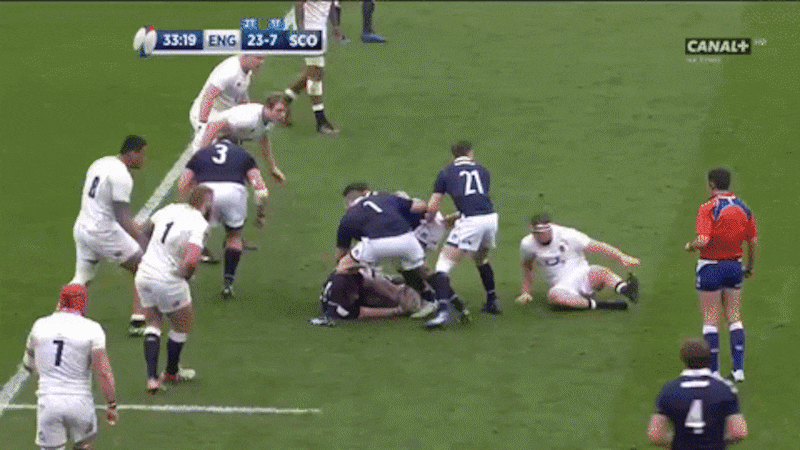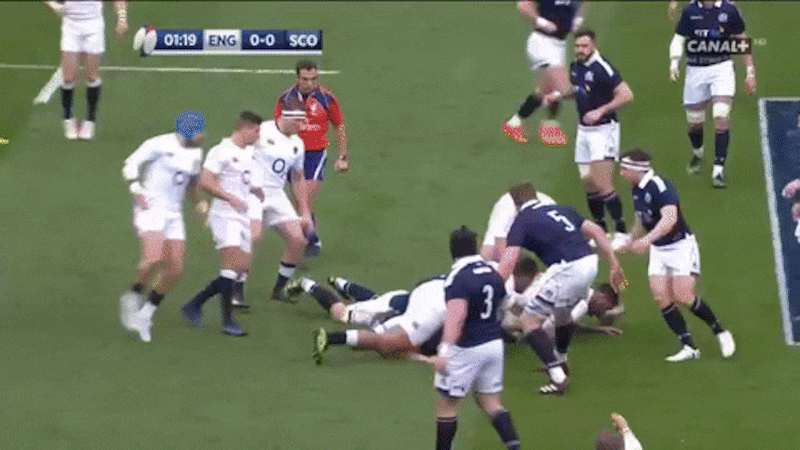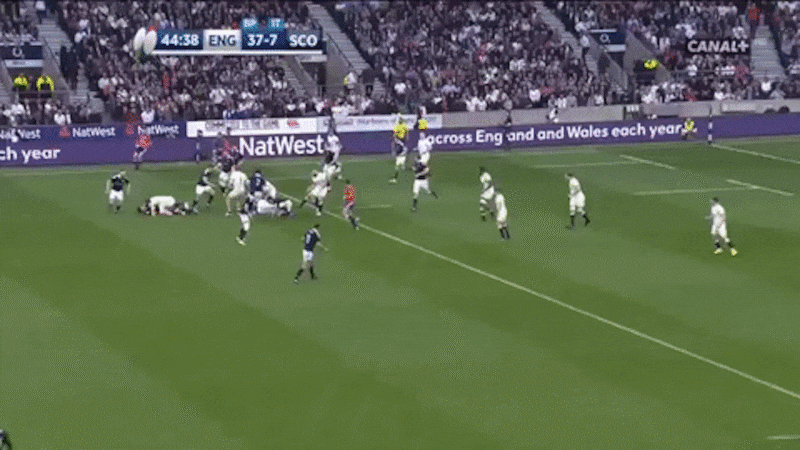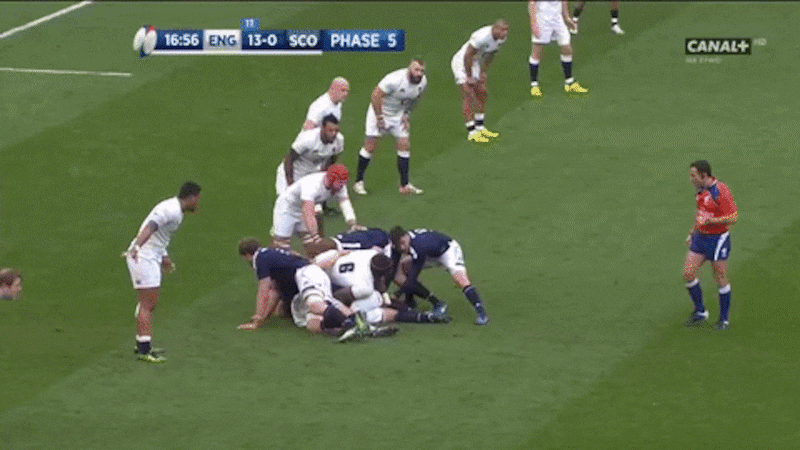There is a way to beat England. This Ireland group know there is a way to beat any team.
England come to Dublin with multiple strengths but the passing of George Ford and particularly Owen Farrell is of the highest quality.
Ford can be turned into a defensive liability. They hide him wherever possible. Also, they only created one try from broken field against Scotland. All their other points came off the lineout or driving through a maul and, really, some inexcusable Scottish defence. It looked like they had never played together before. Ireland are not going to make the same schoolboy errors – and poorly coached schoolboys at that – we saw from Scotland.
Looking back, there is little to be learnt from England’s 61-21 win.
What Italy did for an hour at Twickenham is of far greater value to the Irish coaches this week.
Cardiff on Friday also supplies plenty of lessons.
Robbie Henshaw should not be remembered for that illegal entry into the maul that drove Rory Best over the try line. His defensive display was outstanding and has been throughout the Six Nations. Robbie wasn't seeking out choke tackles, instead he looked like a man who realised just how much power he can generate. He was hurting Welsh men with impact tackles, throwing himself about againstJonathan Davies and Scott Williams, laying down a marker for the dividend which I expect he will collect this summer in New Zealand.
It’s worth noting that without his perfectly weighted grubber kick Ireland would not have had the lineout platform for Best to almost score.
It’s another evolving part of his game.
Wales were beginning to creak around the 70-minute mark. But no points after all the pressure proved the winning and losing of the game.
Ifs and buts would have been dealt with by Monday morning. The stakes are too high to stand still with regret.
Smallest man
England are beatable, I do believe this and so do the players in Carton House.
How their defence coach Paul Gustard uses Ford is very smart. David Humphreysled the defensive line in a similar fashion for Ireland as Ford does for England. He rushes up on occasion, and while it's a useful ploy when possession is static, it has the potential to leave them exposed. He's not a bad defender, rarely shirks collisions, and there's plenty of northern grit in how he plays but he is their smallest man.

Ford rushing up has value. It means he can dictate the line speed, forcing the rest to stay linked, but that’s the height of his effectiveness in defence. England are structured this way to shield him from Sean O’Brien, CJ Stander or whoever can run over him and do serious damage. He also stands at scrumhalf for defensive lineouts and just blitzes the first opposing 10.
Again, that makes him difficult to target. But not impossible.
Farrell, the other playmaker in their side, is an entirely different proposition. He literally brings those Rugby League genes into rugby union. While a slightly smaller 12 than Henshaw, he’s deceptively strong.
I know from experience. In 2014, when they beat us 13-10 at Twickenham, I remembered being hit by Farrell. I've been hit by plenty of centres down through the years but he stands out in Test rugby. His timing in the tackle is usually spot and he’s hard.
The attacking dynamic between Ford and Farrell has become a primary weapon for England under Eddie Jones. The midfield was where Stuart Lancaster’s England came up short at the World Cup when chopping and changing at centre is well documented.
Jones probably expected to build a new midfield around Manu Tuilagi.
The Ford-Farrell axis seemed like a stop-gap but, in fairness to the pair of them, they are crucial to how England release huge forwards in wide channels or put Jonathan Joseph through holes.
Any teenager with aspirations of playing professional rugby should study the quality of their passing.
The pair of them are the best distributors in this year's Six Nations.
Ball in two hands to keep the defence honest with their ability to keep it on the inside hip, while running straight, and Farrell’s quick release is worth six to eight metres for the man running onto it.

Early in the second half on Saturday, Scotland failed to secure clean lineout possession five metres from the English try line. Nathan Hughes pounced to rumble over the 22. The slickness of Ford to Farrell – going right to left, which is marginally his weaker side – had Joseph putting Mike Brown over half way.

It is great to watch. Here's how England can hurt any team: Farrell stayed alive to play scrumhalf as Joe Launchbury went another eight metres in field. Scotland, understandably panicking, conceded a penalty on the ground from the next carry by Joe Marler, again, towards the middle of the pitch.
Farrell landed the 40 metre penalty to make it 40-7 as every point on offer was gratefully snapped up.
This looks very simple (and it is if practiced for a thousand hours).
The width and accuracy of both passes had Joseph coasting into space, as they cover 60 metres in a few seconds.
Scotland were so, so poor but the pass is exactly where the next man wants it.
Ireland will have a long day at the office if they don’t bring a plan to counteract Farrell and Ford. There is a subtlety to Farrell’s out-to-in movement which could open Ireland up if there’s any poor individual reads or body positioning.
So the threat is very real.
But Ireland's 10, 12, 13 access will not be passive or naive while Keith Earls andSimon Zebo won't sit off like the Scottish wingers.
For Joseph's second try I can see Earls staying square and connected, telling Garry Ringrose to hit his man.
On the flip side Scotland really should have exploited England out wide like they did to every other team. Ford’s presence can be exposed in open play after a few phases.
Genuine depth
With 17 minutes played, and the game not entirely a lost cause at 17-0 and Scotland back up to 15 players, it looked to me like Jack Nowell came off his wing to ensure Ford didn't have to tackle a flanker (John Barclay) alone.

Nowell's hit on Barclay denied an offload and Stuart Hogg a clear run to the line, similar to his try against Ireland, but by coming off his wing Nowell seemed to be helping Ford.
Great teams learn how to turn defeats into motivation in order to win tournaments. Ireland are not the All Blacks so recent results should not be viewed as a crisis. Losing in Murrayfield, while very disappointing, and again in Cardiff merely reinforced the fact that we punch well above our weight in international rugby.
England shoehorned Farrell into the 12 position and it worked out for them because Jones can just pick strike runners – like Joseph, Nowell, Elliot Daly andAnthony Watson – outside their dual playmakers.
Ireland don’t have the same array of options.
We, on the other hand, must make do with what we have as we’ve always done. Maybe the next generation of academy graduates coming out of the provincial systems will give us genuine depth in every position but that is a luxury only England and New Zealand currently possess.
I think we need to see Jared Payne on the pitch Saturday evening.
Payne brings a level of composure and rugby intellect, both sides of the ball, which should be utilised. He understands when the opportunity has been created, no matter how small, and steps into first receiver when the moment demands it. This can relieve the emphasis on Johnny having to create so many Irish scores.
Second playmaker
International teams that are consistently winning all have a second playmaker.
When Joe Schmidt joins up all the dots there is a road map – from this Six Nations– to beat England.
Frustrate them. Farrell and Ford struggled for long periods when Italy got under their skin with non-rucks. I don’t think we’ll do that but be certain that Joe will have a clever plan.
Scotland scored three tries on Saturday. Italy got two against them.
Hold on to possession long enough in their territory and opportunities will follow. Ireland are well capable of doing this against any team, and Payne provides an attacking alternative when it comes to the creativity Ireland need right now. The pressure of winning the title is off (granted, for both sides). We are in Dublin. It is, still, England.
They are going for a world record of wins. It is really a game of hide and seek.
If Ireland seek out Ford in open field they can hurt England, drag him into the physicality of the game. Every single point will need to be figured out but this should not be a tough final week down in Carton House. Mental focus comes almost automatically as everyone wants a chance at redemption. They don’t need to atone for the general performance in Cardiff, which I thought was more or less up to standard (tough loss to a good team), rather the result.
The most stressful part of the week is already over. Joe would have switched a few players around in training, kept them guessing, worried some of them. That always leads to interesting pitch sessions. Once selection is decided, this group of Irish players will want their last match until June to be remembered for the correct reasons.
There is no need for any new forms of motivation. It’s all there in front of them. Joe will deliver a winning game plan – he always does – and if the players carry it out the Six Nations that no one predicted will end the way we all hoped.













